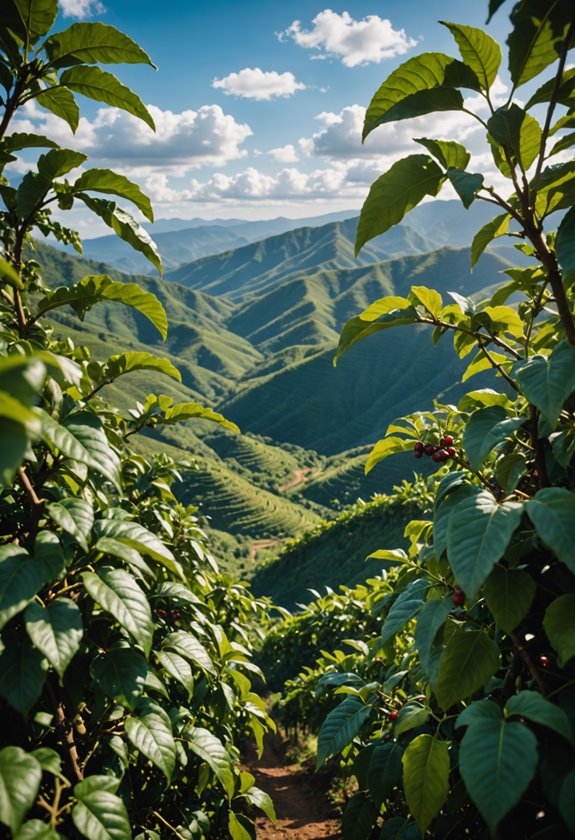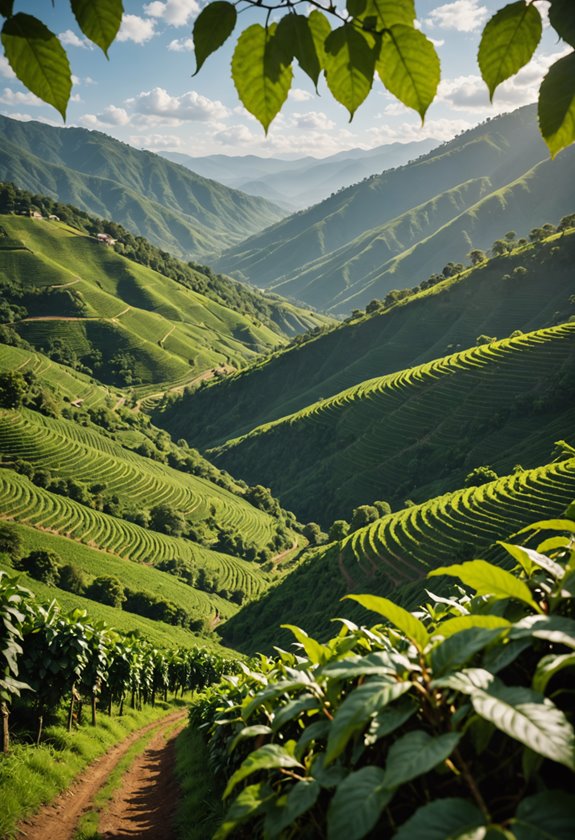Which Countries Are the Largest Producers of Coffee Beans?
Let's investigate the major players in coffee bean production worldwide. Brazil stands out as the top producer, responsible for about 29% of the global supply, with its perfect coffee-growing conditions. Vietnam follows closely, focusing primarily on strong beans, which are essential for instant coffee, contributing to 18% of production. Colombia, known for its rich, aromatic Arabica beans, plays a significant role too, while Ethiopia, the coffee's birthplace, provides unique flavors representing 4% of global yield. Indonesia completes the list with products from Sumatra and Java. Each country's output and characteristics shape the lively coffee market, uncovering rich coffee traditions and innovations.
Key Takeaways
- Brazil is the largest coffee producer, contributing 29% of global coffee production.
- Vietnam ranks second, producing 18% of the world's coffee, mainly robusta beans.
- Colombia is the third-largest coffee producer, known for its high-quality Arabica beans.
- Indonesia is the fourth-largest producer, offering diverse coffee varieties with rich flavors.
- Ethiopia, the birthplace of coffee, contributes 4% to global production with unique flavor profiles.
Global Coffee Production Leaders

When it comes to global coffee production, a few countries stand out as the leaders. Brazil, the largest coffee producer, contributes a significant 29% of total coffee production, with an impressive 2.68 million metric tons annually. Its vast plantations primarily cultivate Arabica beans, known for their smooth, mild flavor.
Let's examine how Vietnam follows closely as the second-largest producer, emphasizing the cultivation of strong Robusta beans. These beans are essential in instant coffee and espresso blends, with Vietnam generating over 1.5 million metric tons each year, making up 18% of global coffee production.
Colombia is another key player, ranking third with about 8% of the world's coffee supply. Its renowned Arabica beans are grown mainly in regions like Antioquia and Caldas, where the climate and altitude create ideal growing conditions.
Ethiopia, the birthplace of coffee, offers unique Arabica bean flavors that contribute 4% to global coffee production. With over 421 thousand metric tons annually, Ethiopia's coffee is celebrated for its distinct taste profiles.
As you investigate these countries' contributions to the coffee industry, you'll gain a deeper appreciation for the global coffee sector and its diverse origins.
The success of these leading producers can be attributed to their optimal cultivation techniques and favorable climate conditions that support robust coffee bean production.
Economic Impact and Market Dynamics
The economic impact of coffee production extends far beyond just the beans in your cup. Coffee-producing countries play an essential role in the global economy, with Brazil leading as the largest coffee producer, contributing about 37% of global coffee production. This dominance greatly influences coffee prices and supply chains worldwide.
Coffee's Role in Developing Economies
In many developing countries, coffee production is a lifeline. Major companies like McDonald's prioritize using premium Arabica beans to maintain quality standards across their global operations. It supports local employment, sustains livelihoods, and enhances the economy. For instance, in Ethiopia, coffee constitutes roughly 10% of the national GDP. Coffee plantations provide jobs and are fundamental for economic stability. The Minas Gerais region stands out as one of Brazil's most significant coffee-producing areas, known for its ideal growing conditions.
Market Characteristics and Price Fluctuations
Market characteristics in the coffee industry are intricate. Vietnam, the second-largest producer, supplies around 17% of the world's coffee, primarily focusing on robusta beans. These beans are key players in the global market, affecting pricing strategies of major coffeehouse chains. Their competitive pricing and sourcing tactics directly impact farmer income and sustainability efforts.
Fluctuations in coffee prices, often driven by global supply chain disruptions, pose economic challenges for these coffee-producing countries. These nations wield considerable influence in the international coffee market, but they also face vulnerabilities.
Let's examine these characteristics to understand their global significance.
Profiles of Top Producing Nations

Understanding the global coffee market means looking closely at the nations that fuel its production. You can't talk about coffee without mentioning the largest coffee-producing country: Brazil. It contributes about 37% of the world's coffee, growing both Arabica and Robust beans on 2.2 million hectares. This vast production makes Brazil a powerhouse in the coffee world.
Next, consider Vietnam, the second-largest producer. It provides around 17% of global coffee, primarily focusing on Robust coffee. Most cultivation happens in the Central Highlands, giving Vietnam a reputation for its strong, hearty flavors.
Now, let's investigate Colombia, known for its high-quality Arabica coffee beans. Ranking third globally, Colombia produces approximately 760 thousand metric tons annually. Its beans are renowned for their aromatic flavor, making them a favorite among coffee aficionados.
Here's a quick rundown of the top coffee-producing nations:
- Brazil: Largest producer, excels in both Arabica and Robust.
- Vietnam: Second largest, focuses on Robust.
- Colombia: Third largest, famous for Arabica.
Indonesia and Ethiopia also play significant roles in the coffee scene. Indonesia, the fourth-largest, offers diverse varieties with rich, earthy flavors from regions like Sumatra and Java.
Ethiopia, the birthplace of coffee, produces primarily Arabica beans known for their genetic diversity and unique flavor profiles.
Coffee trees in these regions require careful cultivation, with first harvests occurring typically three to four years after planting.
Future Trends in Coffee Production
As the coffee industry evolves, future trends in coffee production are shaping how we grow and consume this beloved beverage.
Let's investigate these trends, beginning with the increasing demand for sustainable practices. You're seeing producers shift towards environmentally friendly methods, aligning with consumer preferences for fair trade and eco-conscious products.
Climate Change and Coffee Cultivation
Climate change poses significant challenges to coffee cultivation. Traditional growing regions might see reduced yields due to altered weather patterns.
However, this opens doors for emerging regions to become coffee producers, diversifying global production and presenting new flavors.
Technological Advancements and Efficiency
Technological advancements like precision agriculture and improved processing techniques are revolutionizing coffee farming.
You're witnessing increased efficiency and quality in coffee production, ensuring that each cup you enjoy meets high standards.
Specialty Selections and Consumer Preferences
As consumer preferences shift toward health-conscious and premium products, the industry is adapting with innovative blends and specialty selections.
You're likely to find unique flavors and higher-quality beans at your local café, reflecting this trend.
Rising labor and shipping costs are driving producers to seek more efficient cultivation methods while maintaining quality standards.
Frequently Asked Questions
Who Is the Top 5 Coffee Producer in the World?
You'd probably guess Brazil leads as the top coffee producer. Vietnam follows closely, then Colombia, known for its Arabica beans. Indonesia and Ethiopia round out the top five, each offering unique flavors and substantial contributions to the market.
Where Does the US Get Coffee From?
You import most of your coffee from Brazil, which supplies 37% of your coffee needs. Vietnam and Colombia follow, providing 18% and 8%, respectively. You also source coffee from Honduras, Indonesia, and Ethiopia, enhancing your choices.
What Are the Top 5 Countries That Export Coffee?
You're curious about coffee exports, so here's the scoop: Brazil leads, followed by Vietnam, Colombia, Indonesia, and Ethiopia. These countries dominate the market, each contributing unique flavors and beans that reach global coffee lovers.
What Country Produces 40% of the World's Coffee?
You're curious about the country producing 40% of the world's coffee. It's Brazil, dominating the global market with its vast coffee plantations and diverse Arabica beans. Their tropical climate guarantees a consistent, high-quality coffee supply annually.







